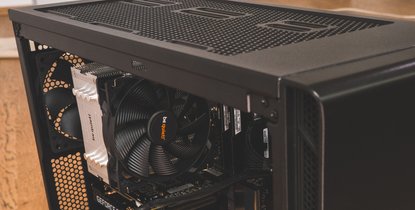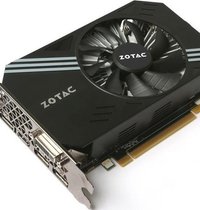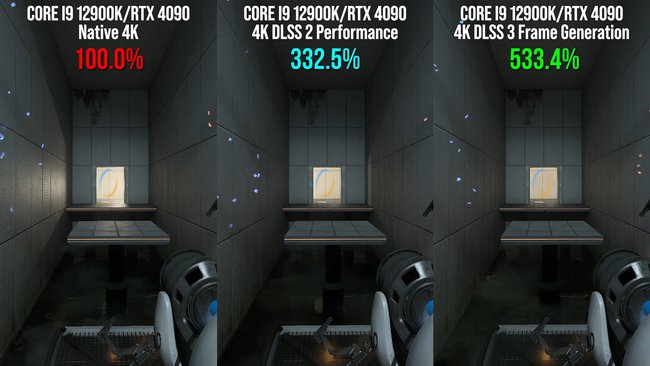Nvidia’s new graphics cards have an absolute wonder technology
With DLSS 3, the newly introduced Nvidia graphics cards of the 4000 series have integrated a technology that can magically increase the FPS by up to five times. Games appear much smoother on corresponding screens. After initial skepticism, a first look at it shows that it works – and shockingly well.
A snag at the beginning: DLSS 3 is only supported by the new Nvidia graphics cards of the 4000 generation, which celebrate their market launch in mid-October. In addition, the games have to be specially adapted for this.
However, the experts at Digital Foundry already have access to the new graphics hardware and some games (Marvel’s Spider-Man, Portal RTX, Cyberpunk 2077) in DLSS 3-supporting pre-release versions for PC. in one Video they give a fascinating insight into how smooth the images are that DLSS 3.0 can bring to the screen. The result: the combination of resolution and temporal upscaling can Quadruple or even quintuple FPS in games.
DLSS: Ways out of the bottleneck
To understand what DLSS 3 does, a digression. Gaming in 2022 has a luxury problem: Modern consoles and PCs are rarely able to deliver high resolutions, high frame rates and high details with features such as ray tracing to the screen at the same time. Current screens (TV sets, but more and more monitors as well) are capable of 4K resolution, HDR and 120 Hz, but they cannot be exhausted in this way – theoretically. That’s why game engines and gaming hardware dominate increasingly sophisticated tricks to “pretty up” the raw images delivered by the GPU.
Nvidia was with his DLSS (short for Deep Learning Supersampling) baptized technology pioneering in this area. DLSS can use machine learning algorithms to upscale images, for example from 1080p to 4K resolution. Since DLSS 2 at the latest, the results have often looked just as good, sometimes even better than images in native 4K resolution.
DLSS 3 a revolution? Daniel disagrees.
DLSS 3 creates higher FPS from practically nothing
Meanwhile, AMD (FSR 2.0) and Intel (XeSS) have followed suit with their own upsampling methods, which also bring good results. However, Nvidia has another ace up its sleeve with the latest DLSS version – and it’s technologically absolutely amazing. Because individual images will be with DLSS 3.0 not only in the image, but also prettied up in the temporal dimension.
In other words: Between two images calculated in the conventional way, the graphics card can create and output an intermediate image with DLSS 3. The main processor doesn’t have to do anything for this, the GPU is also only slightly loaded. For example, 30 FPS becomes 60 FPS or 60 FPS becomes 120 FPS. In connection with the “classic” extrapolation of the resolution as in DLSS 2.0, there is even one Quadruple FPS (Frames per second) and more inside, as the measurements from Digital Foundry prove.
Soap opera effect, but good
The idea is not new. Numerous televisions, for example, also master motion smoothing through artificial intermediate images – this is how it is created so-called soap opera effect. The biggest problem with these algorithms (apart from disregarded artistic intentions) is the time offset of the screen output. This may not matter for films, series and live television, but in games with Motion Smoothing the input delay is so high that the controls seem sluggish and playing is no longer fun. Input lag is the time between an input such as pressing a button and an output, i.e. an action that is displayed on the screen.
DLSS 3 compensates for the problem by generating the intermediate images with special hardware on the graphics processor in an extremely short time, i.e just a few milliseconds. Combined with Nvidia’s Reflex technologywhich additionally reduces the input lag, according to measurements by Digital Foundry, the input lag should be as good as when you play the corresponding game “normally”, i.e. without DLSS and Reflex.
Also in things Quality should be superior to existing DLSS algorithms, can even compete with offline rendering methods like Adobe PixelMotion. Although there are occasionally artifacts that appear “wrong” when viewing individual generated images, these only appear to occur sporadically in complex situations and are practically unnoticeable in fast movements.
Bottom line, judging from the first impressions Digital Foundry has gotten, DLSS 3 seems to be yet another big leap forward in machine learning-assisted image enhancement. For us as players, that means nothing less than higher (perceived) performance when gamingwhich you still need when using 4K screens and maybe even 8K TVs in the future and/or when using ray tracing.
More FPS “for nothing” – that sounds almost too good to be true! A technology for good motion interpolation in games represents a revolution. However, DLSS 3 will only become really interesting in terms of breadth when the technology also finds its way into entry-level and mid-range graphics cards – or even into consoles. In the current generation, only Nintendo uses chip hardware from Nvidia – but in a Switch 2 or Pro, DLSS 3 would certainly make an excellent impression. Apart from that, it’s now: Go AMD and Intel – imitate, there’s a new benchmark!







